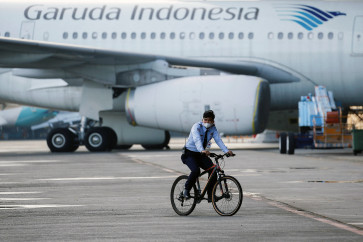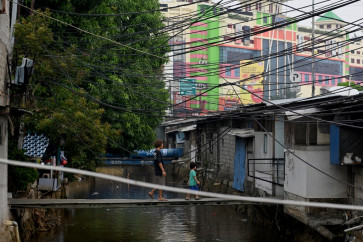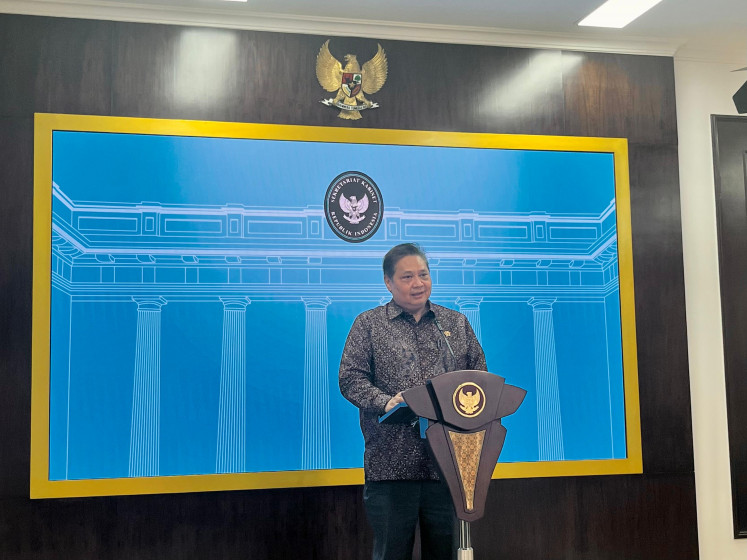Limiting foreign aid, but increasing reliance on China
When Australia reduced its foreign aid to Indonesia by 40 percent in 2015, Indonesia’s Foreign Ministry spokesman Arrmanatha Nasir responded “Indonesia at the moment is no longer a country that needs aid for development
Change text size
Gift Premium Articles
to Anyone

When Australia reduced its foreign aid to Indonesia by 40 percent in 2015, Indonesia’s Foreign Ministry spokesman Arrmanatha Nasir responded “Indonesia at the moment is no longer a country that needs aid for development.”
At face value, this seems to be the case. The Development Assistance Committee (DAC) of the OECD released new foreign aid data in October. They show that net foreign aid to Indonesia from DAC member countries and from multilateral aid agencies like the World Bank and the AIB have decreased.
Following the 2004 Aceh tsunami disaster, foreign aid peaked at US$2.5 billion in 2005. Since then, it decreased to a negative $483 million in 2014 and a negative $43 million in 2015. Indonesia’s traditional foreign aid donors, such as United States, Japan, Australia and other DAC members, are still major aid donors to Indonesia. But Indonesia’s repayments of concessional loans from DAC countries have started to exceed new aid commitments from DAC countries.
Foreign aid was a key feature of Indonesia’s economic development during 1967-2003. Together with the public revenues from oil and gas exports, it was one of the planks that sustained public expenditure and recovery from the economic woes of the Sukarno regime in the mid-1960s.
But Indonesia’s parliament passed legislation in 2003 and 2004 that created an integrated public budget and required a reduction of foreign aid to 3 percent of the annual budget. Its purpose was to limit dependence on foreign aid and also limit what was perceived to be the influence of foreign aid donors on Indonesia’s development policies. And in 2007, the Indonesian government ended the “Consultative Group on Indonesia,” the international group of aid donors that had long coordinated foreign aid to the country.
Since then, increasing aid-related debt repayments caused the foreign debt of the Indonesian government to decrease from $62 billion in 2011 to $49 billion in 2014, according to Bank Indonesia (BI). Nevertheless, this debt increased again to $51 billion in 2016. What happened?
The answer is that Indonesia has accepted increasing foreign aid from non-DAC countries. And to stay within the legal 3 percent maximum contribution of foreign aid to Indonesia’s public budget, foreign aid from DAC countries had to decrease to less than the repayments to DAC countries in order for Indonesia to take advantage of non-DAC foreign aid, especially from China.
Why is China’s foreign aid so special that the Indonesian government prefers it to foreign aid from DAC countries? China is not a DAC member and does not report to DAC. Nor does it report on the foreign aid that it extends to recipient countries as grants or concessional loans. It has therefore long been unclear how much and what kind of foreign aid China was channeling to Indonesia.
Recently, AidData, an institution associated with College of William and Mary in the US, published a new data base on China foreign aid 2000-2014. It is based on public information, such as project announcements, press releases and press reports.
The definition of aid projects and programs in this database includes grants and concessional loans with low interest and/or long grace periods until first repayments are due and/or long repayment terms. By far most Chinese aid comes as concessional loans provided by China’s state-owned banks such as the Exim Bank of China, not as government-to-government grants.
Indonesia is not the largest recipient of Chinese aid. It received just 2.4 percent of total Chinese aid during 2000-2014. Nevertheless, this was altogether $17 billion for 86 projects, or on average $ 2.5 billion per year. This is about half of the turnover by Chinese firms on completed contracted projects in Indonesia, according to the Statistical Yearbook of China, as Chinese firms turned over $4.8 billion in 2015, including private projects.
Almost all of the Chinese foreign aid consisted of concessional loans. That is why the foreign debt of Indonesia’s government increased again during 2015 and 2016, despite the government’s intention to reduce dependence on foreign aid.
China’s aid to Indonesia does not seem very different from bilateral DAC aid and multilateral aid, which also consisted to a large extent of concessional loans, depending on aid donor country. However, Chinese foreign aid is different from that of DAC member countries, because the AidData database shows that almost all Chinese aid in Indonesia was committed for infrastructure development.
By contrast, DAC countries and multilateral agencies also support aid projects that helped Indonesia to achieve its Millennia Development Goals with aid projects focused on poverty alleviation, education, environment, sanitation, nutrition, public health, capacity building in Indonesia’s public services, strengthening civil society etc.
Except for a slum project through the new Asian Infrastructure Investment Bank, the establishment of Confucius Institutes at seven universities in Indonesia, and scholarships for Indonesian students to study in China, most of China’s aid to Indonesia finances bridges, roads, power plants, and a limited number of railway projects, designed and constructed by Chinese firms.
This is of course in line with what many consider to be China’s core competencies in aid delivery, which had been honed through rapid infrastructure development in China in recent decades. It is also in line with one of the main priorities in Indonesia’s current development program: infrastructure development to alleviate the country’s very significant infrastructure deficit.
On the other hand, there is the question whether Indonesia can continue to live up to the intentions of 2003-2004 to limit the influence of aid donors on its development policies, if one of its key development priorities increasingly depends on one provider of foreign aid.
________________________
The writer is an associate professor in international business, Australian National University.
A shorter version appeared at eastasiaforum.org.









